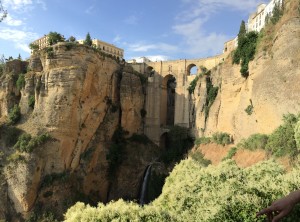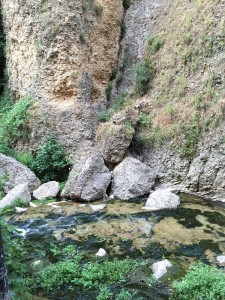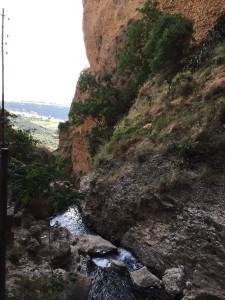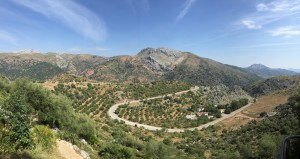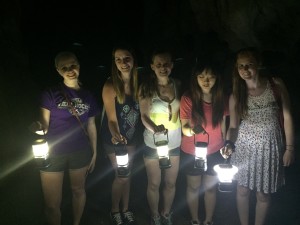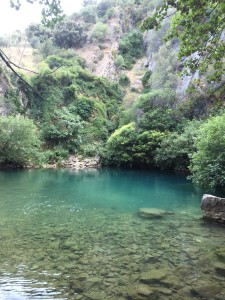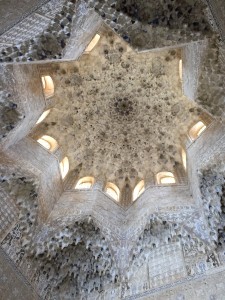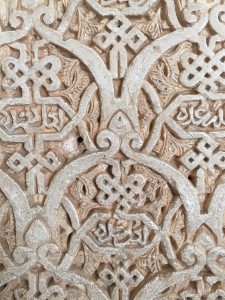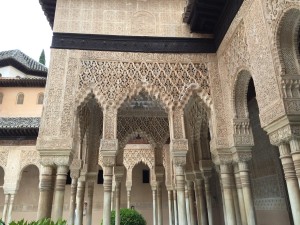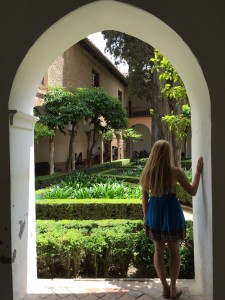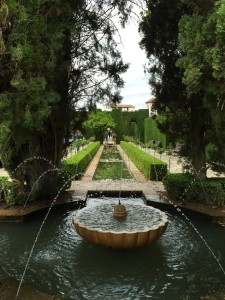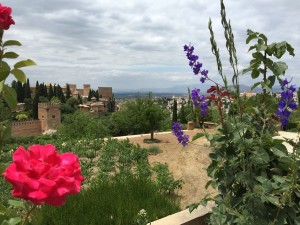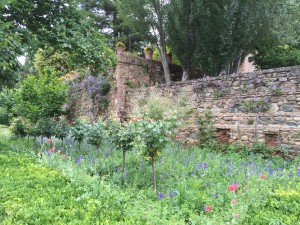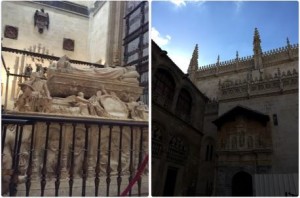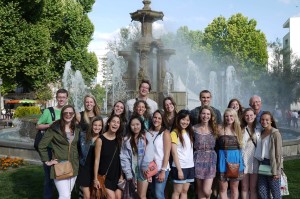Wrapping up our final full week was so strange to do. How could it be that we’d be leaving so soon already? Even though the trip was drawing to a close, we still managed to pack the week full of activities and sightseeing.
Getting in Touch with Our Nature-y Sides
That Tuesday, we did something that we’d all put on our Ronda bucketlists–go under the bridge. The distance between the top of the bridge and the bottom of the gorge is about 120 meters, or 390 feet. The hike down itself was no more than a steep walk, but we picked up a few friends on the way. One of them was a Ronda native named Antonio who shared his own study abroad experience with us to a place not far away from Penn State: Lancaster, PA. Small world, right?
The underbelly of the bridge was much different than I had expected. While I had been told that it was a gorge, I didn’t realize how big it actually was.
Spanish terrain as a whole is pretty arid and rocky, but in parts like this it’s a bit greener, too. I really liked seeing the land as it was, undisturbed and without having been built on even though it was only a few hundred feet upwards.
Delving Deeper
The next day was filled with more nature-esque things. The first was a visit to a cave called La Pileta.. This cave was home to over 18,000 murciélagos, or bats. On the walls were paintings over 30,000 years old. Some were even older! They depicted animals such as horses, bulls, and fish. So as not to disturb the bats or damage the cave drawings, we weren’t permitted to take photos in these innermost parts of the cave, but we did manage to snag one in the entrance with our lanterns that we used as guides throughout the tour.
Following La Pileta, we went off to yet another cave: La Cueva del Gato, or The Cave of the Cat. It gets its name for its catlike stone structure.
Contrary to its appearance, this place is not what meets the eye. The pond is deeper than it seems. The cliffs are higher. And the water is very, VERY cold. Though the day itself was about 85 degrees, the water was shaded by foliage and settled in at what felt like a Penn State winter itself. ¡Qué frío!
….we went in anyway.
And we froze.
And I would 100% do it again.
I’m talking the kind of cold where your entire body feels numb and makes it hard to breathe once it gets past your rib cage, the kind of cold where your skin comes out in a carefully calculated combination of red and purple with goosebumps out the wazoo depending on the time spent inside. But we did it under this rationale: How many times are you really ever in Spain?
More Nature, Plus History
Think about the architecture that one can see today. Think about the details. Think about the color. More importantly, think about the technology used to create it. Now picture something equally as unique, but tenfold the detailing and started construction in 889. This is known as none other than La Alhambra, a fortress and palace located in Granada.
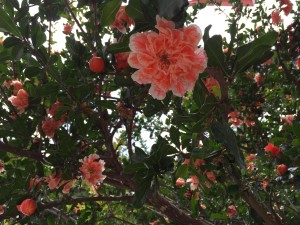
This is a plant that Granada is known for, subsequently named La Granada. Though it may seem foreign, the US sees them quite frequently: pomegranates.
I like to compare La Alhambra to an architect’s dream. I have never been so in awe of any building as much as I was of this one. From the moment we walked in, our entire group was floored. For something to be so old and yet so intricate was incredible.
Of the many spots we visited inside, one was called El Patio de Leones, or The Patio of the Lions. It’s known for its water structure in the center, encircled by lions and also by its patterned arches.
But my favorite part of all was a section called El Generalife, which is La Alhambra’s gardens. They’re not comparable to anything I’ve seen in the past, but I like to describe them with 3 B’s: big, beautiful, and breathtaking. Words don’t do it justice.
Without a doubt, La Alhambra has been the best part thus far. Nothing can compare to the detail, the beauty, and the magnificence found in one place.
The City Itself
And then came Granada. We were told that next on the Agenda was seeing Ferdinand and Isabella’s graves. Crazy, right? But in the meantime, we had a few hours to explore the city on our own.
I set off by myself. I still had some gifts to buy. But more importantly, I had yet to venture anywhere in Spain alone. I wanted to see it for myself. I didn’t go far–just to a few shops in an open market and then off to a main street–but it was refreshing to take everything in in the way I saw it. I’ve found that opinions of things are best made when uninfluenced by the words or actions of those around you. I bought some boomerangs and wallets, talked to some shopkeepers, and saw a parrot casually sitting atop someone’s shoulder. I gave some spare change to the happiest homeless man I’d ever seen. He was singing a song and dancing with the cup, throwing ‘ayudame’ into the verse, which means help me. After a while, it was time to head back. But having wandered by myself was a nice refresher.
The graves themselves were underneath the main floor building, but not quite like a basement. There was a small set of stairs that led down to a room covered by a glass window immediately followed by stairs back to the top. The statuesque replicas were above in the main floor of the church. Standing next to two of the most powerful people in the history of the world makes you feel really, really small.
And with that, our venture to Granada drew to a close–but not before grabbing a quick group photo by the fountain in one of the city’s squares!
Location: Granada
Loading map...



